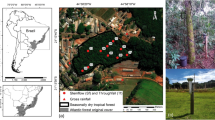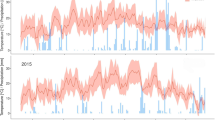Abstract
Key Message
Tree size and exposure is a key driver of stemflow; canopy heterogeneity leads to spatial randomness of stemflow; stemflow impacts soil moisture in superficial layers.
Abstract
Stemflow (SF) plays a relevant role in forest hydrology by delivering rain to the soil around trees. This study sought to explore the effects of tree traits on the amount of SF in an Atlantic Forest remnant in Southeast Brazil using stepwise regressions from April 2016 to March 2017. In addition, we evaluated the spatial association among trees in regard to SF using bivariate Ripley’s K as well as the impact of SF on soil water content (SWC) at five different layers (up to 1 m) using linear regression. We found that the diameter at breast height (DBH), percentage of mosses on the tree trunk, average leaf area, and relative position of the tree within the canopy were selected as explanatory variables in total and monthly average SF models. For the wet season SF models, crown area, percentage of mosses cover on the trunk, average leaf area, and relative position within the canopy were the selected variables, whereas for the dry period SF models, DBH and percentage of mosses were selected. A complete spatial randomness (CSR) between the SF classes was confirmed. We observed that SF impacted the SWC in the superficial layers. Therefore, tree size, exposure, and seasonal differences were the key drivers of SF amount due to the leaf losses during the dry period. Heterogeneity of the canopy is probably responsible for the CSR of SF in the study area. We expect that this study will contribute to the understanding of the hydrological processes in the Atlantic forest hotspot by clarifying the aspects of water capture by trees.




Similar content being viewed by others
References
Barbier S, Balandier P, Gosselin F (2009) Influence of several tree traits on rainfall partitioning in temperate and boreal forests: a review. Ann For Sci 66:602. https://doi.org/10.1051/forest/2009041
Barbosa JM, Melendez-Pastor I, Navarro-Pedreño J, Bitencourt MD (2014) Remotely sensed biomass over steep slopes: an evaluation among successional stands of the Atlantic Forest, Brazil. ISPRS J Photogramm Remote Sens 88:91–100. https://doi.org/10.1016/j.isprsjprs.2013.11.019
Bollen WB, Chen CS, Tarrant RF (1968) Effect of stemflow precipitation on chemical and microbiological soil properties beneath a single alder tree. Proc Nothwest Sci Assoc Annu Meet 149–156
Carlyle-Moses DE, Schooling JT (2015) Tree traits and meteorological factors influencing the initiation and rate of stemflow from isolated deciduous trees. Hydrol Process 29:4083–4099. https://doi.org/10.1002/hyp.10519
Crockford RH, Richardson DP (1990) Partitioning of rainfall in a eucalypt forest and pine plantation in southeastern Australia: IV. The relationship of interception and canopy storage capacity, the interception of these forests, and the effect on interception of thinning the pine plantation. Hydrol Process 4:169–188
Crockford RH, Richardson DP (2000) Partitioning of rainfall into throughfall, stemflow and interception: effect of forest type ground cover climate. Hydrol Process 14:2903–2920
Dietz J, Hölscher D, Leuschner C, Hendrayanto (2006) Rainfall partitioning in relation to forest structure in differently managed montane forest stands in Central Sulawesi, Indonesia. For Ecol Manag 237:170–178. https://doi.org/10.1016/j.foreco.2006.09.044
Dormann CF, Elith J, Bacher S, Buchmann C et al (2013) Collinearity: a review of methods to deal with it and a simulation study evaluating their performance. Ecography 36:27–46
Fleischbein K, Wilcke W, Goller R et al (2005) Rainfall interception in a lower montane forest in Ecuador: Effects of canopy properties. Hydrol Process 19:1355–1371. https://doi.org/10.1002/hyp.5562
Germer S, Werther L, Elsenbeer H (2010) Have we underestimated stemflow? Lessons from an open tropical forest. J Hydrol 395:169–179. https://doi.org/10.1016/j.jhydrol.2010.10.022
González-Martínez TM, Williams-Linera G, Holwerda F (2017) Understory and small trees contribute importantly to stemflow of a lower montane cloud forest. Hydrol Process 31:1174–1183. https://doi.org/10.1002/hyp.11114
Herbst M, Rosier PTW, McNeil DD et al (2008) Seasonal variability of interception evaporation from the canopy of a mixed deciduous forest. Agric For Meteorol 148:1655–1667. https://doi.org/10.1016/j.agrformet.2008.05.011
Herwitz SR (1986) Infiltration-excess caused by Stemflow in a cyclone-prone tropical rainforest. Earth Surf Process Landf 11:401–412. https://doi.org/10.1002/esp.3290110406
Hildebrandt A, Al Aufi M, Amerjeed M et al (2007) Ecohydrology of a seasonal cloud forest in Dhofar: 1. Field experiment. Water Resour Res 43:1–13. https://doi.org/10.1029/2006WR005261
Hofhansl F, Wanek W, Drage S et al (2012) Controls of hydrochemical fluxes via stemflow in tropical lowland rainforests: Effects of meteorology and vegetation characteristics. J Hydrol 452–453:247–258. https://doi.org/10.1016/j.jhydrol.2012.05.057
Hölscher D, Köhler L, Leuschner C, Kappelle M (2003) Nutrient fluxes in stemflow and throughfall in three successional stages of an upper montane rain forest in Costa Rica. J Trop Ecol 19:557–565. https://doi.org/10.1017/S0266467403003614
IBGE (2012) Manual Técnico da Vegetação Brasileira. Série Manuais Técnicos em Geociências 1, 2ª edição revista e ampliada. IBGE, Rio de Janeiro
Johnson MS, Lehmann J (2006) Double-funneling of trees: stemflow and root-induced preferential flow. Ecoscience 13:324–333
Junqueira JA, Mello CR, Owens PR et al (2017) Time-stability of soil water content (SWC) in an Atlantic Forest—Latosol site. Geoderma 288:64–78. https://doi.org/10.1016/j.geoderma.2016.10.034
Kramer I, Hölscher D (2009) Seasonal variability of interception evaporation from the canopy of a mixed deciduous forest. Ecohydrology 2:102–114
Levia DF (2004) Differential winter stemflow generation under contrasting storm conditions in a southern New England broad-leaved deciduous forest. Hydrol Process 18:1105–1112. https://doi.org/10.1002/hyp.5512
Levia DF, Germer S (2015) A review of stemflow generation dynamics and stemflow-environment interactions in forest and shrublands. Rev Geophys 53:673–714
Levia DF, Herwitz SR (2005) Interspecific variation of bark water storage capacity of three deciduous tree species in relation to stemflow yield and solute flux to forest soils. Catena 64:117–137. https://doi.org/10.1016/j.catena.2005.08.001
Levia DF, Van Stan JT, Mage SM, Kelley-Hauske PW (2010) Temporal variability of stemflow volume in a beech-yellow poplar forest in relation to tree species and size. J Hydrol 380:112–120. https://doi.org/10.1016/j.jhydrol.2009.10.028
Li X-Y, Liu L-Y, Gao S-Y et al (2008) Stemflow in three shrubs and its effect on soil water enhancement in semiarid loess region of China. Agric For Meteorol 148:1501–1507. https://doi.org/10.1016/j.agrformet.2008.05.003
Liu W, Fox J, Xu Z (2002) Nutrient fluxes in bulk precipitation, throughfall and stemflow in montane subtropical moist forest on Ailao Mountains in Yunnan, south-west China. J Trop Ecol 18:527–548. https://doi.org/10.1017/S0266467402002353
Lopes SF, Vale VS, Schiavini I et al (2014) Canopy stratification in tropical seasonal forests: how the functional traits of community change among the layers. Biosci J 30:1551–1562
Lorenzon AS, Dias HCT, Tonello KC (2015) Escoamento Da Água Da Chuva Pelo Tronco Das Árvores Em Uma Floresta Estacional Semidecidual. Rev Árvore 39:423–430
Mežaka A, Brūmelis G, Piterāns A (2008) The distribution of epiphytic bryophyte and lichen species in relation to phorophyte characters in Latvian natural old-growth broad leaved forests. Folia Cryptogam Estonica 44:89–99
Myers N, Mittermeier RA, Arantes AA, Prado J, Ranal MA (2000) Biodiversity hotspots for conservation priorities. Nature 403:853–858
Nasi R, Wunder S, Campos A. JJ (2002) Forest Ecosystem Services: can they pay our way out of deforestation? Paper presented at the roundtable on forests sponsored by the Global Environment Facility; 11 March, New York. Bogor (Indonesia): CIFOR (Center for International Forestry Research), for Global Environment Facility
Návar J (2011) Stemflow variation in Mexico’s northeastern forest communities: Its contribution to soil moisture content and aquifer recharge. J Hydrol 408:35–42. https://doi.org/10.1016/j.jhydrol.2011.07.006
Park A, Cameron JL (2008) The influence of canopy traits on throughfall and stemflow in five tropical trees growing in a Panamanian plantation. For Ecol Manage 255:1915–1925. https://doi.org/10.1016/j.foreco.2007.12.025
Parker GG (1983) Throughfall and stemflow in the forest nutrient cycle. Adv Ecol Res 13:57–133. https://doi.org/10.1016/S0065-2504(08)60108-7
Phillips OL, Brienen RJW (2017) Carbon uptake by mature Amazon forests has mitigated Amazon nations’ carbon emissions. Carbon Balance Manag 12:1. https://doi.org/10.1186/s13021-016-0069-2
Pressland AJ (1976) Soil moisture redistribution as affected by throughfall and stemflow in an arid zone shrub community. Aust J Bot 24:641–649. https://doi.org/10.1071/BT9760641
Pypker TG, Levia DF, Staelens J, Van Stan JT (2011) Canopy structure in relation to hydrological and biogeochemical fluxes. In: Levia DF, Carlyle-Moses D, Tanaka T (eds) Forest hydrology and biogeochemistry: synthesis of past research and future directions. Springer, Dordrecht, pp 371–388
R Development Core Team (2016) R: a language and environment for statistical computing. R Foundation for Statistical Computing, Vienna
Ribeiro MC, Metzger JP, Martensen AC, Ponzoni FJ, Hirota MM (2009) The Brazilian Atlantic Forest: how much is left, and how is the remaining forest distributed? Implications for conservation. Biol Conserv 142:1141–1153
Ripley BD (1987) Statistical inference for spatial processes. Cambridge University Press, New York, NY
Schooling JT, Carlyle-Moses DE (2015) The influence of rainfall depth class and deciduous tree traits on stemflow production in an urban park. Urban Ecosyst 18:1261–1284. https://doi.org/10.1007/s11252-015-0441-0
Schwärzel K, Ebermann S, Schalling N (2012) Evidence of double-funneling effect of beech trees by visualization of flow pathways using dye tracer. J Hydrol 470–471:184–192
Shinzato ET, Tonell KC, Gasparoto EAG, Valente ROA (2011) Escoamento pelo tronco em diferentes povoamentos florestais na Floresta Nacional de Ipanema em Iperó, Brasil. Sci For 39:395–402
Siegert CM, Levia DF (2014) Seasonal and meteorological effects on differential stemflow funneling ratios for two deciduous tree species. J Hydrol 519:446–454. https://doi.org/10.1016/j.jhydrol.2014.07.038
Sparovek G, De Jong Van Lier, Dourado Neto Q D (2007) Computer assisted Koeppen climate classification: a case study for Brazil. Int J Climatol 27:257–266. https://doi.org/10.1002/joc.1384
Staelens J, Herbst M, Hölscher D, De Schrijver A (2011) Seasonality of hydrological and biogeochemical fluxes. In: Levia DF, Carlyle-Moses D, Tanaka, T (eds) Forest hydrology and biogeochemistry: synthesis of past research and future directions. Springer, Dordrecht, pp 521–539
Tabarelli M, Aguiar AV, Ribeiro MC, Metzger JP, Peres CA (2010) Prospects for biodiversity conservation in the Atlantic Forest: lessons from aging human-modified landscapes. Biol Conserv 143:2328–2340
Taylor M, Mulholland M, Thornburrow D (2008) Infiltration characteristics of soils under forestry and agriculture in the upper Waikato catchment
Van Stan JT, Siegert CM, Levia DF, Scheick CE (2011) Effects of wind-driven rainfall on stemflow generation between codominant tree species with differing crown characteristics. Agric For Meteorol 151:1277–1286. https://doi.org/10.1016/j.agrformet.2011.05.008
Van Stan JT, Van Stan JH, Levia DF (2014) Meteorological influences on stemflow generation across diameter size classes of two morphologically distinct deciduous species. Int J Biometeorol 58:2059–2069. https://doi.org/10.1007/s00484-014-0807-7
Acknowledgements
We gratefully acknowledge the financial support provided by FAPEMIG (Fundação de Amparo à Pesquisa do Estado de Minas Gerais; PPM-X- 045/16), CNPq (Conselho Nacional de Desenvolvimento Científico e Tecnológico; Processo: 401760/2016-2), and CAPES (Coordenação de Aperfeiçoamento de Pessoal de Nível Superior; Bolsa PNPD). We kindly thank Renato Antônio da Silva for assistance with field work.
Author information
Authors and Affiliations
Contributions
MdCNST was responsible for the conception and writing of the manuscript; CRdM has lead the research project, collaborated with the conception and given critical revision of the article; VAdO has helped with writing, and critical revision; MHN has helped with data analysis and interpretation (statistical support); VOS, AFR, and GJA have collaborated with data collection (field work) and critical revision of the manuscript.
Corresponding author
Ethics declarations
Conflict of interest
The authors declare that they have no conflict of interest.
Additional information
Communicated by A. Gessler.
Rights and permissions
About this article
Cite this article
Santos Terra, M.d.N., de Mello, C.R., de Mello, J.M. et al. Stemflow in a neotropical forest remnant: vegetative determinants, spatial distribution and correlation with soil moisture. Trees 32, 323–335 (2018). https://doi.org/10.1007/s00468-017-1634-3
Received:
Accepted:
Published:
Issue Date:
DOI: https://doi.org/10.1007/s00468-017-1634-3




